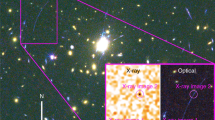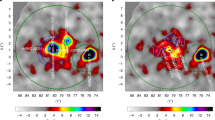Abstract
SOME twenty X-ray sources are now known, among them the well known objects M87 and the Crab nebula. Two X-ray sources (Sco X-1 and Cyg X-2) have been optically identified with previously unknown objects which have a stellar appearance and the characteristics of old novae1,2. Most X-ray sources remain unidentified, however. Most of them lie at low galactic latitudes, and it seems possible that many are objects similar to Sco X-1. These objects are not prominent at radio wavelengths and previous attempts to detect radio emission from Sco X-1, the strongest X-ray source, have yielded only upper limits to its flux density (refs. 3–5 and Hogg and Johnson quoted in ref. 6). The flux density of Sco X-1 has now been measured as 0.021 ± 0.007 flux units (1 flux unit = 10−26 W m−2 Hz−1) at a wavelength of 4.6 cm. This value is substantially below the previously determined upper limits.
This is a preview of subscription content, access via your institution
Access options
Subscribe to this journal
Receive 51 print issues and online access
$199.00 per year
only $3.90 per issue
Buy this article
- Purchase on Springer Link
- Instant access to full article PDF
Prices may be subject to local taxes which are calculated during checkout
Similar content being viewed by others
References
Sandage, A. R., Osmer, P., Giacconi, R., Gorenstein, P., Gursky, H., Waters, J., Bradt, H., Garmire, G., Sreekantan, B. V., Oda, M., Osawa, K., and Jugaku, J., Astrophys. J., 146, 316 (1966).
Giacconi, R., Gorenstein, P., Gursky, H., Usher, P. D., Waters, J. R., Sandage, A., Osmer, P., and Peach, P. V., Astrophys. J. Lett., 148, L129 (1967).
Johnson, H. M., Astrophys. J., 144, 635 (1966).
Hobbs, R. W., and Hollinger, J. P., Science, 155, 448 (1967).
Yokoi, H., Sato, T., and Morimota, M., Pub. Astro. Soc. Japan, 18, 185 (1966).
Heeschen, D. S., Astron. J., 72, 1118 (1967).
Peterson, L. E., and Jacobson, A. S., Astrophys. J., 145, 962 (1966).
Matthews, T. A., and Sandage, A. R., Astrophys. J., 138, 30 (1963).
Willstrop, R. V., Mon. Not. Roy. Astro. Soc., 121, 17 (1960).
Johnson, H. M., Astrophys. J., 146, 960 (1966).
Tucker, W., Astrophys. J. Lett., 149, L105 (1967).
Greene, J., Astrophys. J., 130, 693 (1959).
Manley, O. P., Astrophys. J., 144, 1253 (1966).
Author information
Authors and Affiliations
Rights and permissions
About this article
Cite this article
ANDREW, B., PURTON, C. Detection of Radio Emission from Scorpio X-1. Nature 218, 855–856 (1968). https://doi.org/10.1038/218855a0
Received:
Published:
Issue Date:
DOI: https://doi.org/10.1038/218855a0
This article is cited by
-
Sco X-1
Space Science Reviews (1977)
-
Generation of relativistic particles by neutron stars in the state of accretion
Astrophysics (1973)
Comments
By submitting a comment you agree to abide by our Terms and Community Guidelines. If you find something abusive or that does not comply with our terms or guidelines please flag it as inappropriate.



